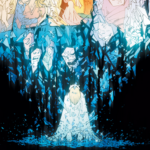
 Self-insertion of an author into their true crime book can come off a bit pretentious. But it has also resulted in some of the best works of true crime writing: Anne Rule’s The Stranger Beside Me, Truman Capote’s In Cold Blood, and, most recently, Michelle McNamara’s I’ll Be Gone in the Dark. In these works, the autobiographical element is done in such a way to elevate, rather than detract from, the book giving the reader a single character whom they can relate to through the (sometimes multiple) crimes being explored. The author’s relation to, or obsession with, the crimes and hunt for the killer draws the reader in. They also position us to care as much as they do.
Self-insertion of an author into their true crime book can come off a bit pretentious. But it has also resulted in some of the best works of true crime writing: Anne Rule’s The Stranger Beside Me, Truman Capote’s In Cold Blood, and, most recently, Michelle McNamara’s I’ll Be Gone in the Dark. In these works, the autobiographical element is done in such a way to elevate, rather than detract from, the book giving the reader a single character whom they can relate to through the (sometimes multiple) crimes being explored. The author’s relation to, or obsession with, the crimes and hunt for the killer draws the reader in. They also position us to care as much as they do.
 McNamara’s highly anticipated book, detailing not only the cases but her involvement in the investigation, was an instant bestseller (I highly recommend the audiobook; it’s so good I’ve listened to it twice). Michelle’s retelling of the crimes and the effect on the victims is compassionate and intimate in a way that is usually lost in the often sensationalist nature of true crime reporting. The victims weren’t just victims in her portrayals; they were real people whose lives were irrevocably affected by one single night.
McNamara’s highly anticipated book, detailing not only the cases but her involvement in the investigation, was an instant bestseller (I highly recommend the audiobook; it’s so good I’ve listened to it twice). Michelle’s retelling of the crimes and the effect on the victims is compassionate and intimate in a way that is usually lost in the often sensationalist nature of true crime reporting. The victims weren’t just victims in her portrayals; they were real people whose lives were irrevocably affected by one single night.
The book is, in my opinion, perfection in the genre and could very effectively stand on its own in perpetuity. So the announcement that I’ll Be Gone in the Dark was being made into a docu-series left me with mixed feelings. I’ve watched a lot of true crime documentaries over the years, and they’re usually over-hyped, breathless, biased, or sensationalized (or a combination of all of those). Would this documentary employ the bad re-enactment scenes that true crime is so known for? Would it spend most of its time calling GSK a “genius,” like so many Ted Bundy docs? Will the victims and survivors be portrayed as sexualized, screaming dolls? Thankfully, the answer to all of these concerns is “No.” Nor does the documentary try to eclipse the work it’s based on. Instead, the documentary stands as a companion work, drawing from and adding to the representation created so skillfully by McNamara. The documentary and book harmonize each other in a way that I’ve never seen before.
The documentary and the book explain the case: the victims, the investigators, the online community of citizen detectives, and McNamara herself. The usual true crime fare is present, including, but not limited to, news footage, interviews with the victims and detectives, and images of case files. Also included are unique contributions, home movies, and interviews with McNamara, footage of the infamous town hall meeting that was thought to have inspired GSK to make his first attack on a couple, and readings from McNamara’s diary.
Even the B-roll was fresh and interesting. B-roll is what is used to add visual interest or additional information, like photographs, stock footage, and re-enactments. It’s a very important aspect in documentaries, because there’s only so long we can watch a talking head or accompanying audio that has no video component. B-roll is typically where true crime documentaries drop the ball: think of seeing the same graduation photo of the victim, with a slow pan, five times in an episode of Forensic Files. But the B-roll never felt like filler or an afterthought. It was well thought-out, staged, and used to bolster the interviews and information being delivered to the viewer. It was always intentional, whether to set the scene, provide information, or lighten the mood, like when Paul Haynes re-enacts receiving “The Motherlode” of case files framed as a low-key heist movie. Good B-roll is one of those aspects of film making that I geek out over, and this series has done a stellar job.

Some of the most striking inclusions are the intimate interviews with Patton Oswalt, McNamara’s widower. For those of us who already knew McNamara’s fate, some of these scenes are positively heartbreaking. For viewers who didn’t, the documentary skillfully foreshadows her sudden and unexpected death by accidental overdose, sowing the seeds of how this case was affecting her mental health and how she was dealing with it. As with all other aspects of the series, this is handled with intimacy and respect.
Of course, some of the most important parts of the documentary that were not, or could not, be in the book were two things—the identification and capture of Joseph James DeAngelo as the Golden State Killer. Also, the gathering together of his surviving victims and the important support and community that they created. This provides the conclusion that was unavailable in McNamara’s lifetime. The book ended with McNamara’s “A Letter to an Old Man,” where she addressed the as-yet-unknown monster at the heart of her book. She imagined him now as a feeble, pathetic old man and predicted that the terror and power he holds would vanish when he is named and brought into the light for all to see. And her prediction came true. The documentary ends with his capture and arraignment, as well as interviews with some of his family members who provide information about his life and give context (if such can be had) to some of the abuse he suffered before becoming an abuser himself.
Michelle set out to catch a killer. She didn’t crack the case herself and didn’t put a name to the monster in the dark. But she brought the case into the public’s attention, coined the name “Golden State Killer,” galvanized law enforcement agencies and individuals, and championed the use of DNA genealogy, all of which ultimately lead to his capture. She knew more about the case than anyone. The profile she developed fit him like a glove. She didn’t catch the killer, but he wouldn’t be sitting in jail today without her. I’ll Be Gone in the Dark lovingly tells that story.




